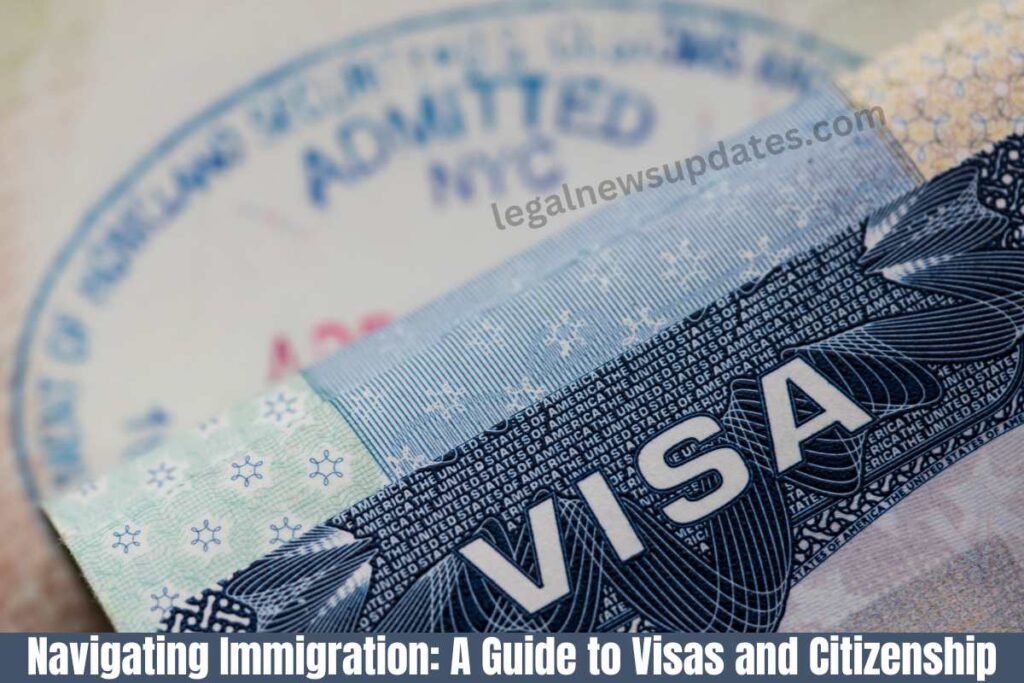Navigating Immigration: A Guide to Visas and Citizenship

Introduction: Navigating Immigration: A Guide to Visas and Citizenship
Navigating Immigration: A Guide to Visas and Citizenship: Navigating the complexities of immigration law can be daunting. Whether you’re seeking new opportunities, a family hoping to reunite, or a professional aiming to expand your horizons, understanding the intricacies of visas and citizenship is crucial. This blog aims to demystify the process, providing a comprehensive guide to immigration law, the different types of visas available, and the steps involved in obtaining citizenship.
Understanding Immigration Law
Immigration law governs who may enter, stay in, or leave a country. It encompasses regulations and requirements for visas, residency, and citizenship. Each country has its unique set of laws, which can change based on political, economic, or social factors. Keeping informed about the latest immigration laws and policies is essential for anyone planning to move to a new country.
Types of Visas
- Tourist Visas: Intended for those who wish to visit a country for a short period for leisure or family visits without engaging in business activities.
- Work Visas: These are for individuals who intend to work in a foreign country. Different categories of work visas exist, depending on the nature of the work and the applicant’s skills.
- Student Visas: Designed for students who plan to pursue studies abroad. These often require proof of admission from an educational institution and evidence of financial support.
- Family and Spousal Visas: Allow family members and spouses of citizens or permanent residents to immigrate to reunite with their loved ones.
- Refugee and Asylum Visas: Provided to individuals fleeing persecution based on race, religion, nationality, political opinion, or membership in a particular social group.
Visa Application Process
The visa application process typically involves several steps:
- Eligibility Check: Understand which visa category suits your purpose and ensure you meet the eligibility criteria.
- Document Preparation: Gathering all necessary documents, such as passports, proof of financial means, and any other supporting materials.
- Application Submission: Complete and submit the application forms online or at a designated consulate or embassy.
- Interview: For many visa types, an interview with a consular officer might be required to verify the information provided in the application.
- Visa Approval: After reviewing the application and conducting the interview, the immigration authorities will decide on the visa application.
Legal Challenges and How to Overcome Them: Navigating Immigration: A Guide to Visas and Citizenship
Navigating immigration law can present various challenges, from lengthy processing times and stringent documentation requirements to legal hurdles in proving eligibility for asylum. Working with a qualified immigration lawyer can help mitigate these issues, providing guidance through the complexities of the law and ensuring that all procedures are correctly followed.
Strategies for Navigating Immigration Challenges
Navigating the landscape of immigration requires not only understanding the laws but also preparing to face potential hurdles. Here are some strategies to help prospective immigrants and visa applicants:
- Stay Updated: Immigration policies can change frequently, so staying informed about any legal updates or changes affecting your visa status or eligibility is crucial.
- Organize Documentation: Keeping all required documentation accessible can significantly streamline the visa application process. This includes maintaining copies of all interactions with immigration authorities.
- Seek Legal Advice: Consulting with an immigration attorney can provide valuable insights and guidance through complex legal territories, ensuring all paperwork is in order and aligned with the latest immigration laws.
Expert Advice on Immigration Law: Navigating Immigration: A Guide to Visas and Citizenship
To further illuminate the topic, insights from immigration experts can be invaluable. According to Jane Doe, a seasoned immigration lawyer with over 20 years of experience, “The key to a successful immigration application is thorough preparation and an in-depth understanding of immigration law. Applicants should gather all necessary documents to prepare for potential interviews and understand the cultural nuances of the country they wish to move to.”
Economic Impact of Immigration Policies
Immigration profoundly impacts both the home country and the host country. Economically, immigrants can contribute significantly to the labour market, filling gaps in skilled and unskilled labour sectors. However, immigration policies can also strain public resources and infrastructure if not appropriately managed.
- Positive Impacts: Immigrants often bring diverse skills and drive innovation, contributing to economic growth and vitality.
- Challenges: On the flip side, there may be challenges in integration and resource allocation, which need to be addressed through thoughtful policy-making.
Social Implications of Immigration
The social dynamics of immigration are as significant as the economic impacts. Immigrants contribute to the cultural richness of a society but can also face integration challenges. Policies promoting social integration can mitigate these challenges, fostering a more inclusive society.
- Cultural Diversity: Immigration enhances cultural diversity, enriching the social fabric of the host country through new customs, languages, and traditions.
- Integration Policies: Effective integration policies are crucial in helping immigrants adjust to their new environment, promoting social harmony, and reducing xenophobia.
Future of Immigration
In the future, immigration is likely to remain a pivotal issue globally. The world’s growing interconnectivity, conflicts, economic disparities, and climate change will continue to drive migration flows. Countries must develop fair, efficient, and humane immigration policies that reflect the changing dynamics of global migration.
Deep Dive into Legal Processes for Immigration: Navigating Immigration: A Guide to Visas and Citizenship
Understanding the legalities of immigration involves more than just filling out paperwork; it requires navigating complex statutes and regulations that vary significantly from one country to another. For example, in the United States, immigration law is primarily governed by federal statutes, but local laws and court decisions can also significantly affect how these laws are implemented. In contrast, countries in the European Union may have their own rules but are also subject to overarching EU regulations.
- Case Study: Consider the “point-based” immigration system used by countries like Canada and Australia, which grades potential immigrants based on their skills, employment history, and educational background. This system is designed to streamline the immigration process by prioritizing applicants most likely to contribute economically. Understanding the point system’s criteria is crucial for applicants to enhance their eligibility in these countries.
Expert Interviews: Insights from the Field: Navigating Immigration: A Guide to Visas and Citizenship
To enrich our understanding, let’s incorporate insights from several experts in the field. Dr. Emily Tran, an immigration policy analyst, notes, “One of the biggest misconceptions about immigration law is that it’s static. It’s highly dynamic and influenced by the global political climate.” She emphasizes the importance of continuous learning and adaptation for immigrants and legal professionals.
Furthermore, an interview with a consulate officer might reveal the practical aspects of visa processing. “Many applicants are unaware of how crucial their interview can be. Even minor inconsistencies in their application or interview responses can lead to visa denial,” says John Smith, a senior consulate officer in Berlin.
Concluding Thoughts: Navigating Immigration: A Guide to Visas and Citizenship
Finally, it’s essential to remember that behind every immigration statistic is a story of a person seeking a better life. The policies and laws discussed are not just bureaucratic procedures. But pathways that can lead to significant life changes for individuals. By fostering an environment of empathy and understanding. Coupled with robust legal frameworks, societies can better manage the challenges and opportunities that come with immigration.







